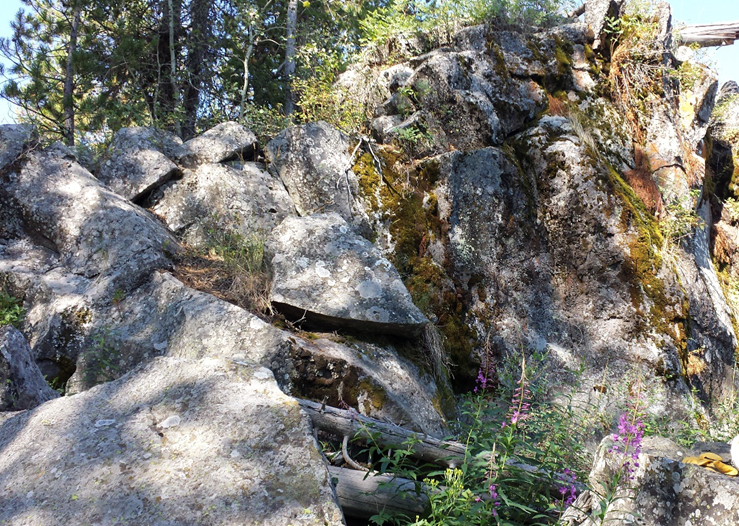Thinking outside the caldera: Understanding basaltic eruptions at Yellowstone
Yellowstone is most famous for huge explosive eruptions that create large calderas. Outside Yellowstone Caldera, however, there have been numerous more fluid lava flow eruptions.
Yellowstone Caldera Chronicles is a weekly column written by scientists and collaborators of the Yellowstone Volcano Observatory. This week's contribution is from Cole Messa and Ken Sims, from the University of Wyoming, and Mark Stelten, geologist with the U.S. Geological Survey and deputy scientist-in-charge of the Yellowstone Volcano Observatory.
The Yellowstone Plateau Volcanic Field has produced three caldera-forming eruptions over the last 2.1 million years, including the Huckleberry Ridge Tuff (2.1 million years ago), the Mesa Falls Tuff (1.3 million years ago), and the Lava Creek Tuff that produced Yellowstone caldera 631,000 years ago. Between these large eruptions, numerous lava flows and domes erupted within the calderas produced by these large eruptions. Although most eruptions at Yellowstone tend to be rhyolite in composition—high in silica and very viscous, which is why eruptions can be very explosive and also produce thick lava flows—these magmas represent the end product of a large magmatic system that extends from ~4 km depth to the base of the crust (~40 km). In fact, rhyolite is only present in significant quantities between approximately 4 km and 15 km depth in crust, whereas the rest of the magmatic system is likely dominated by basalt, which comes from deeper in the Earth, is lower in silica content, and is much more fluid.
Geologists have long known that large, shallow rhyolite magma bodies like that at Yellowstone need a large supply of heat to keep remain active and not freeze solid. This heat source is probably related to the transport of hot, basaltic magmas from deep in the crust to shallower portions of the crust where rhyolite resides. Furthermore, an influx of heat from deeply sourced basalts may be required to “prime” the rhyolite system for an eruption. In other words, the influx of heat into the shallow crust can cause the proportion of liquid magma in the magmatic system to increase, possibly leading to an eruption.
To test these ideas and better understand the role that the deeper, basaltic part of the magmatic system plays in priming eruptions in the shallow, rhyolitic part, a research group representing a collaboration between the University of Wyoming’s High-Precision Isotope Laboratory (WILD) and the USGS Volcano Science Center recently measured eruption ages using the argon dating technique on suite of samples collected from throughout the Henrys Fork Caldera region, located just west of present day Yellowstone caldera near the town of Island Park, Idaho. Henrys Fork Caldera is home to much of Yellowstone’s basaltic activity and has gone mostly unresearched since mapping efforts by the late Dr. Robert L. Christiansen were completed in 2001. The new eruption ages, coupled with field mapping efforts, revealed that Henrys Fork Caldera is home to multiple episodes of basaltic lava flow activity over the past 1.3 million years. Importantly, each of these episodes coincides with a period of known rhyolite eruptive activity in the Yellowstone region.
This alignment of eruption timing led the researchers to suggest that periods of volcanic unrest at Yellowstone are characterized by an increase in activity in the lower, basaltic portion of the magmatic system that provides the heat necessary to spur the shallow, rhyolitic portion of the magmatic system into growing and/or erupting. These periods of increased activity in the lower portion of the magmatic system are manifested on the surface as periods where numerous basaltic magmas erupt outside the caldera, while rhyolites, which are less dense, “block” the basalt from rising where a rhyolite magma chamber is present—namely in the area of Yellowstone caldera—but may erupt themselves. This explains why Yellowstone caldera is characterized by numerous episodes of rhyolite lava flow activity that correlate in time with basaltic activity outside the caldera.
Another striking conclusion from the new research is the identification of a basalt eruption that is just 35,000 years old located in the Henrys Fork Caldera region. Previously, it was thought that the youngest eruption in the region was the rhyolite lava of the Pitchstone Plateau about 70,000 years ago, while the youngest known basalt flow was 120,000 years old. The new result means that this 35,000 year old basalt is now the youngest Yellowstone eruption known. The younger age implies that basaltic activity remains possible west of Yellowstone National Park, and that the deeper, basaltic portion of Yellowstone magmatic system has been active since the last known eruption of rhyolite at Yellowstone.
The new research was published in the journal Geology: “New 40Ar/39Ar Eruption Ages Reveal an Important Temporal Relationship Between Mafic and Silicic Volcanism in the Yellowstone Plateau Volcanic Field.”
Get Our News
These items are in the RSS feed format (Really Simple Syndication) based on categories such as topics, locations, and more. You can install and RSS reader browser extension, software, or use a third-party service to receive immediate news updates depending on the feed that you have added. If you click the feed links below, they may look strange because they are simply XML code. An RSS reader can easily read this code and push out a notification to you when something new is posted to our site.





